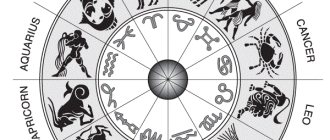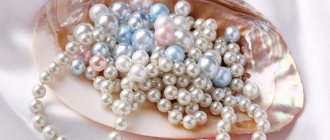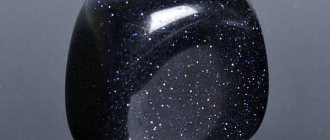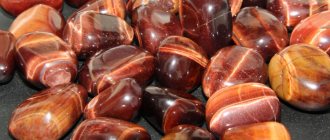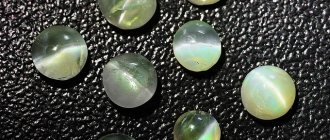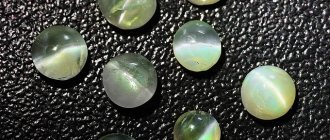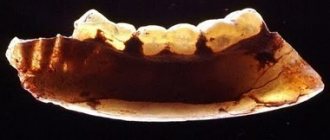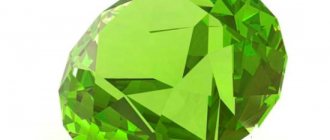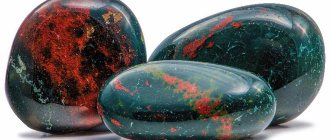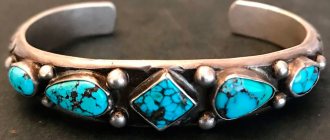| Formula | X2-3Si2O5(OH)4 |
| Color | Dark green, shades of black, brown |
| Shine | Glassy, greasy, waxy |
| Transparency | Opaque |
| Hardness | 2,5 — 4 |
| Cleavage | Absent |
| Kink | Conchoidal |
| Density | 2.2 - 2.9 g/cm³ |
The properties of the stone became part of the Ural legend. Craftsmen from Nikita Demidov's enterprises wove a tablecloth from a coil. After the feast, the owner, in front of Peter I, washed it and sent it to “dry” in the stove. The “snake” canvas remained intact.
Colors and varieties
Serpentine is an opaque mineral, sometimes it can be translucent. It has many varieties that differ in color, shade, pattern.
- Antigorite is a yellow or yellow-green mineral with a glassy luster, inexpensive.
Antigorite
- Bowenite is a translucent gem of light green or pale yellow color. Externally similar to jade.
Egg 48mm Bowenite
- Verdanite is a dark green swamp colored gemstone with black veins. Rich in magnesium.
Verdanite
- Vernantite is a deep green mineral with sparkles.
Vernantite
- Williamsite is a stone with a bluish sea tint, very expensive.
Williamsite
- Nigrescite - color ranges from dark green to black.
Nigrescite
- Ophiocalcite (serpentine marble) is a stone riddled with veins of calcite and dolomite.
Ophiocalcite
- Ophite is a somewhat translucent, uniformly green stone without inclusions.
Ophite
- Porcellophyte is an opaque gem, similar in appearance to porcelain.
Porcellophyte
- Retinolite is a dark orange or sand-colored mineral that casts black.
Retinolite
- Ricolite (poisonous serpentine) is a bright green gem, clearly striped.
Ricolite
- Satellite is a rare variety. An iridescent green mineral with a cat's eye pattern.
Satellite
- Ural (noble serpentine, mosswort) is a gem of pale olive or light green color. Has small black inclusions.
Ural coil
Like any stone, the coil is subjected to tumbling (processing), which emphasizes its external characteristics.
History and origin
People have known about serpentinites for five thousand years. Jewelry and religious objects made of stone older than a thousand years are unearthed in China. The Indians of pre-Columbian America used the serpentine as a talisman. The gem was introduced to Europeans in the 16th century.
Serpentine egg
This mineral received its scientific name serpentinite or serpentine due to its resemblance to snake skin (from the Latin “serpens” - snake). The Russian-language name is serpentine. Other names for the mineral: toligor, flywheel, Korean (or new) jade.
There are enough legends about the origin of the stone, all based on the “snake” theme.
- The worldwide legend is associated with the biblical story of the Serpent - the tempter of Eve. Having given her the fruit of the knowledge of Good and Evil, he insidiously offered to share it with Adam. However, after biting into the apple, he choked. The piece that popped out turned into a green mineral.
- Residents of Southern Europe are confident that the serpentine was a fossilized poison left by reptiles during “weddings.”
- The Russian version connects the birth of the serpentine with the Great Snake. This fabulous Serpent guards the wealth of the Ural Mountains. And the green fragments of serpentinite are petrified fragments of skin, which it sheds in the spring, replacing it with a new one.
In fact, the gem is a product of metamorphism of local magnesium-rich or carbonate rocks.
Raw moss
Application
Serpentinite fountain in the Stockalper Palace
Due to their low hardness and good texture, serpentine stones have been used for centuries as an ornamental and decorative facing stone, and in rare cases for stone carving and cameo making. In Europe, serpentinites have been known as an ornamental stone for over 400 years and have been used to make countertops and apothecary vessels.
In Russia, serpentine has long been used for cladding interiors in palaces, in combination with other types of colored stones or metal - for the manufacture of stone-cutting products, as well as Florentine mosaics. In the royal suburban palaces of Russia - Gatchina and Pavlovsk - there were sets of artistic work, carved from coils, used in palace everyday life.
Carefully!
To avoid counterfeits, you should purchase jewelry made from coils only in jewelry stores. Craftsmen use exclusively high-quality stones with high density and rich colors for their work.
Serpentine also makes beautiful boxes, figurines and vases.
Where is serpentine mined?
This mineral is not rare. Serpentine deposits are located not only in Russia; the stone is also actively mined in America, China, Great Britain, India, Italy, New Zealand, Mongolia, Afghanistan, and Cuba. In our country, the largest deposits of serpentine are located in the Urals, Altai, North Caucasus, and in the Orenburg, Siberian and Yakutsk regions. This rock is mined in Kazakhstan, Azerbaijan, and Tajikistan.
Zmeevik – deposits
Rocks are distinguished by the density of the stone and the saturation of the pattern. Varieties of minerals and rocks are naturally found in various birthplaces of snake stone. The main difference is in color.
- Bonewit is not a bright green.
- Williamsite is a blue tint of green.
- Ricolite is a bright tone with clearly visible veins.
- Vernantite is a rich green interspersed with shiny parts of calcite.
- Ophite - noble appearance, even green color.
The coil is quite widespread. Stone is a relatively cheap material. The cost allows you to buy the mineral in large quantities. The price per kilogram ranges between 10 and 60 rubles. They are used to cover large areas: facades, pool walls, fireplaces.
Large developed deposits are located in different parts of the world:
- New Zealand;
- China;
- India;
- Italy;
- Great Britain.
There are also several places for stone quarrying in Russia:
- Ural mountains. Bazhenovskoe and Shabrovskoe.
- Altai region;
- Orenburg region;
- Mountains of the North Caucasus;
- Siberian and Yakutsk regions.
The rock is mined in Kazakhstan, Azerbaijan, and Tajikistan.
Jewelry masters use and select noble samples. The specimens have shine, silkiness, glow, and pattern. The colors of the mineral are a fusion of green with dark tones and a yellow tint. The pattern is created by veins.
Common names of the stone:
- toligor;
- flywheel;
- antigorite;
- Korean jade
Serpentine jewelry
Products made from coil
When choosing jewelry, you should pay attention to the frame of this gem. The best option is a combination of coil with cupronickel, silver and bronze.
It is believed that the interaction of the coil with these metals enhances its valuable properties.
It also goes well with rhodonite, copper, platinum and obsidian.
In addition, the type of decoration is also important. Rings and bracelets strengthen bones, beads cleanse the biofield of negative energy, and earrings relieve migraines.
Usage
Stone is used in many fields
The history of its use by humans began many centuries ago. Archaeologists have found products made from coils dating back to 3 thousand. BC e. made in ancient China. Even then, decorations, various containers and paraphernalia for rituals were made from it. Such finds were discovered in South America, India, and Europe.
A serpentine is a stone whose properties allow it to be used to make various souvenirs. According to the description, it is moderately hard and plastic, which allows it to be widely used as an ornamental material.
In the interior
The following are made from the coil:
- vases;
- caskets;
- tables;
- candlesticks;
- ashtrays;
- figurines and figurines;
- chess.
The production of vases and souvenirs from this mineral can be classified as a separate form of art; they are distinguished by their particular sophistication. And a box made of serpentine stone is similar to jade, but is more affordable at its price.
The discovery of large springs made this gem cheaper and it began to be used as a facing stone for walls, floors, stairs and other building elements. Used for decorating baths and oven lining. They also make tombstones.
In jewelry
Serpentine is an ornamental stone that is used in costume jewelry, sometimes framed in silver or cupronickel; very rarely it can be seen framed in precious metals. Such jewelry has a low price, but looks very impressive thanks to the color and variety of patterns on this mineral.
- To make bracelets, processed polished mineral is used in the form of smooth round beads of different sizes.
- Pendants and earrings are decorated with round or teardrop-shaped cabochons, and also use untreated plates, which are especially decorative.
- Rings are decorated with large oval or round polished inserts, often combined with zirconium or other inexpensive gems.
A correctly selected beautiful piece with a coil is well suited for an everyday look, and some unique pieces that look no less impressive than precious stones can complement a festive look.
Favorable time to buy
It is recommended to buy a coil on the 18th lunar day, and start wearing it from the 4th lunar day. Ideally, when you first get acquainted with a stone, you should hold it in your left hand. Then take it in your hands every day for 2 weeks. And start wearing it only after 2 weeks, putting the jewelry on with your right hand. These manipulations are needed to replenish energy and improve the compatibility of the stone with its owner.
And remember that the mineral cannot be given as a gift. The stone remembers the owner and tightly fuses with him at the energy level. By giving a coil, you give away part of your energy.
Cost of stone coil
There are many varieties of this mineral. The serpentine has a wide range of healing and magical qualities. However, its cost is quite affordable. The fact is that there are a sufficient number of stone deposits in the world. It cannot be called rare. The most famous mining sites are in Siberia and the Urals.
A block of stone that is suitable for finishing work will cost about $350. The mineral is very popular because its small particles are actively used in the creation of jewelry. Any fragment has its own value and becomes a harmonious addition to each piece of jewelry.
The serpentine can be called a cold-blooded, arrogant and unapproachable stone. It does not immediately attract the eye and bewitch. Only select people are able to appreciate its greatness, attractiveness and originality. If a person is not afraid of danger and strives to connect with the powerful energy of the mineral, then the coil will become a useful and necessary acquisition for him.
How to recognize a fake
A box made from a coil
The price of a coil is small, the mineral is common, but it can still be counterfeited. A piece of plastic, painted to look like a gem, itself costs just a penny. So you still need to know how to distinguish a mineral from a fake.
Moreover, only natural stones are suitable for magic and lithotherapy. And even if you are buying just jewelry, it will be unpleasant to overpay.
- Weigh the jewelry in your palm. Serpentinite is quite heavy, unlike plastic.
- The difference between what a coil looks like and a fake one is obvious to the eye. Natural stone always has stripes, inclusions, and stains.
- Hold the product in your hands. The plastic will quickly heat up from the warmth of your palms, but the genuine gem will remain cold.
- Squeeze the stone tightly in your fist. If it is real, you will feel a slight tingling sensation.
But there is no need to scratch the product, as is the case with other gems. The coil is soft and pliable, you will only damage it and will not receive any useful information about authenticity.
Field and production
Many serpentinite deposits are located in the Urals. One of them, Shabrovskoye, (near the village of Shabry) is located 25 km southwest of Sverdlovsk. The breed was discovered in the 40s along the sides of a talc quarry and on nearby hills. During the mining process, more than 20 new objects were identified. New deposits of Belousovskoye, Grigorievskoye, and Mramorskoye were discovered. The Dedyukhinskoye deposit was discovered near Krasnouralsk; there are also deposits near:
- Nizhny Tagil;
- Asbestos;
- Alapaevsk;
- Turgoyak;
- Uchalinsky district in Bashkiria.
There are 22 moss fly deposits in the Urals. The mineral is mined all over the world; facilities are located in Altai, Yakutia, New Zealand, the USA, Cuba, Great Britain, Italy, Azerbaijan, Kazakhstan, India, China, Tajikistan, Mongolia.
How to care for stone
Serpentine vase
To make decorations or amulets made from serpentine pleasing as long as possible, you should take care of them.
Stone products are not recommended to be worn daily. To care for products with this stone, you do not need to purchase special products; it is enough to periodically rinse it under running water for 15–20 minutes. The serpentine has the ability to absorb everything negative around it. Running water, flowing away, takes away all the bad things that the stone has collected. Simply immersing yourself in water will not help.
After rinsing, you just need to place the product on a clean surface until dry or blot it with a clean cloth.
The stone should be protected from scratches and abrasions.
Differences between natural stone coil and artificial
The cost of the coil is quite affordable. However, craftsmen fake it. To do this, they use durable plastic. In order not to buy a fake, you need to pay attention to some points. You should carefully examine the branched stripes located on the stone. They should be varied and non-repetitive. The weight of natural mineral is greater than that of plastic.
Place it on your body. If the stone heats up slowly, it means you have a coil in front of you. Plastic takes on body temperature very quickly.
No need to scratch the stone. Traces remain on the natural coil. It does not boast the strength of other minerals.
The magical properties of the serpentine
Unusual legends about the serpentine made it popular in magical circles. Modern sorcerers love boxes made of this mineral, because if you put talismans in it, they are in a kind of energy safe, which will not allow them to lose their properties. There will be no external influence on them, because the coil absorbs everything negative.
Important!
The coil is capable of absorbing all the surrounding negativity, so it needs to be cleaned regularly. To do this, just place it under running water for a while and then blot it with a soft cloth.
Serpentine bracelet
It is believed that any person striving for self-knowledge needs to wear jewelry made from this stone or have some kind of interior item. The coil increases the desire to move forward, enhances a person’s creative capabilities and research aspirations.
It has a coil and dangerous properties. He is called the tempter according to the first legend about the Snake. It can distract from true goals, luring you onto the path of vice. If a person decides to perform rituals with this mineral, he may find himself in the center of new trials. But having dealt with them, a person will receive a very strong mineral for his use. The serpentine will become his slave, giving him the powers of a shaman.
The stone should be constantly monitored. He has the character of a snake, he hides and waits, but when a person is distracted, he strikes.
Compatibility with names and zodiac signs
Serpentine is a unique stone of the Earth and it is not suitable for everyone. With many zodiac signs he behaves absolutely neutrally, but with others he expresses himself clearly.
As a zodiac amulet, it can be worn by everyone who is ready to overcome all the trials and difficulties of life prepared for them.
Most of all it suits Virgos. The serpentine will help them discover new talents, sharpen their intuition and give creative inspiration. It also goes well with the sign of Capricorn. He will endow people born under this constellation with agility and endurance.
- On the contrary, astrologers do not advise Cancers and Pisces to wear serpentine amulets. This stone will confront them with temptations that can lead to moral degradation;
- It will help Aries to avoid people who are distinguished by their deceit. Aries have high energy from birth, and the stone will not suppress it. The person becomes calmer, nervousness and rudeness appear less;
- For Taurus, the stone will help them become more open, but will give them an understanding of who is worth communicating with and who is not. In addition, the stone prevents unnecessary risks, improves health and makes a person more attractive;
- Geminis who periodically wear the snake stone will become more self-confident. They will finally venture into new acquaintances, affairs, and discoveries. Perhaps they will decide to reconsider their established views and change their lifestyle;
- The Lviv coil can make it more resistant and solid. In addition, their confidence will increase. Leos will be able to do many things in parallel, become more organized and purposeful;
- Libra's constantly changing opinions will become more stable;
- For Scorpios, the stone will create a good atmosphere in order to begin new major projects that a person has not dared to undertake before;
- Sagittarius will bring success and good luck;
- For Aquarius, the Snake stone will help discover new talents.
You should not wear it every day, so as not to harm yourself if it is an amulet that is adjacent to the skin. Two days a week is enough. If this is a pocket amulet, you can use it more often, but you should still take breaks.
Important! It is strictly contraindicated for uninitiated people to use the coil as an amulet!
Since the snake stone has long been called an apothecary stone, it is suitable as a talisman for people in medical specialties: paramedics, nurses, doctors and pharmacists.
The stone provides special protection to people with the names:
- Vladimir;
- Alexei;
- Hope;
- Love;
- Alevtina.
Talismans and amulets
Pyramid coil
The magical capabilities of the stone are used in several directions:
- Amulets with serpentine activate logical thinking and strengthen memory.
- Amulets resist negativity on the physical and mental planes, protecting the house not only from robbers or natural disasters, but also from unkind people.
- A coil is a mandatory attribute when performing rituals to establish connections with earthly or universal forces.
- The stone gives a true vision of the world and awakens intuition.
Serpentine is especially suitable for representatives of the following professions:
- entrepreneurs and businessmen;
- lawyers and jurists;
- for athletes and athletes.
Talismans in the form of a figurine, jewelry or a simple pebble will help them maximize their professional talents, ensure career growth, and success in business.
Description and external signs
Serpentine belongs to a large group of layered silicate minerals, which includes magnesium-iron silicates of polymorphic modification. Serpentine is a rock that is primarily dark green in color and has a unique serpentine pattern, hence its second name, Serpentine. Often found with admixtures of garnet, pyroxene, and olivine. Typical impurities are carbonate, amphibole, talc, chromite.
The structure of the mineral is matted-fibrous, but fine-crystalline and cryptocrystalline masses are also found in nature. What do these gems look like? Crystals can be of various shades: yellow, dark green, spotted, dark, green with white streaks, bold, matte, glassy or pearlescent. Regarding transparency, Serpentine is a translucent, transparent or translucent mineral. Sometimes in nature there are specimens of white, dark red and bluish color. People call this stone moss, mountain flax, toligor, Korean jade.
Healing properties
Serpentine casket and rhodonite.
Healers and alchemists hold the serpentine in special esteem. It is no coincidence that the name of the mineral in their circle is apothecary stone. Even official medicine has recognized that medicines prepared or stored in “snake” containers become stronger.
A beautiful preventative or therapeutic remedy is jewelry with a coil:
- earrings - useful for hypertensive patients, neutralize migraines, headaches, vascular spasms;
- rings or bracelets - help with fractures, cuts, bruises or dislocations;
- beads or necklace - treat inflammation of colds, gastrointestinal diseases;
- rosary - calms the nerves.
The coil has the properties to protect the owner from the evil eye, damage or other mental negativity. The healing effects are enhanced by silver and cupronickel. This is the preferred setting for jewelry.
Serpentine as a healing mineral is used by modern healers:
- kills bad energy in the room;
- gives strength during physical or emotional overload;
- removes toxins and waste;
- reduces irritability and removes excess emotions;
- strengthens the immune system;
- portends the onset of illness, starting to warm up;
- is an effective remedy for snake bites.
The stone is of particular importance as a talisman for children. The coil will develop logical thinking and strengthen the child’s memory.
Medicinal properties: what it can do and how to use it
In ancient times, people believed in the power of stone to heal mental disorders. The coil was worn to get rid of negative energy, damage and the evil eye. Nowadays, healers and doctors of alternative medicine confidently speak about the healing properties of stones:
- inflammations of various types;
- migraine;
- viral and cold manifestations;
- hypertension;
- renal failure;
- problems with the gastrointestinal tract;
- nervous disorders;
- fractures and dislocations;
- excessive excitability.
Earrings or a talisman with a stone will help you get rid of migraines and excessive sleepiness. Accelerate the healing of bones during fractures - rings and bracelets.
It is believed that the green gem not only has healing properties, but is also capable of enhancing the effect of any medicine if it is stored in a container made of mineral, as pharmacists did 400 years ago.
What stones does it go with?
Serpentine is a mineral of the Earth element. Its energy is in harmony with impenetrable, durable “earthly” minerals, including:
- agate;
- turquoise;
- jet;
- nephritis;
- lapis lazuli;
- onyx;
- sarder;
- jade;
- jasper.
Green stone combines aesthetically flawlessly with obsidian or rhodonite. The contrast of color and structure emphasizes the uniqueness of the snake gem.
Description of the stone coil
The mineral has spots and veins. They are set against a greenish-yellow background. This appearance of the stone justifies its name. Serpentine (the name of the group of minerals that includes serpentine) is translated from Latin as “snake.” Sometimes there is such a name as “apothecary stone”. The fact is that previously the coil was used to make medical cups and mortars.
This is a fairly durable stone. He has a beautiful appearance. Its edges are rounded. In most cases, its extraction occurs much faster than other minerals, since it is formed into monoliths of significant size.
It's opaque. The stone contains fibrous veins. It differs from jade in its softer and more pliable structure. The coil is easy to handle.
In addition, the coil can withstand significant temperature changes while maintaining its original appearance.
The meaning of the stone and its physical properties
The meaning of the stone is ambiguous. The serpentine is characterized by many magical properties. Previously, it was an integral attribute of magicians and shamans and was considered a dangerous stone, instilling fear in mere mortals. And now the mineral is used in magic, but it does not cause such horror.
Has the following characteristics and physical properties:
- beautiful glassy oily sheen;
- hardness up to 4 units on the Mohs scale;
- The mineral is quite dense. Its density is 2.6 g/cm³;
- good viscosity;
- fibrous, layered or scaly structure;
- heating temperature up to 600 degrees;
- high fire resistance.
It lends itself well to various types of processing, for which it is valued to this day.
The chemical formula of the gem is MgO[(OH)8Si4O10]. It contains Mg, Al, Zn, Mn, Ni, and iron ions.
